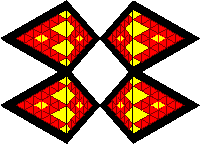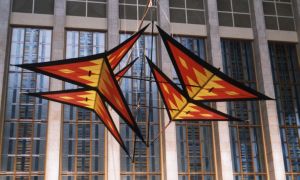LynnBox - Story
The illustrations of large chain kites in historical photos and the models of large kites on the most diverse kite celebrations released the desire with us to build likewise once a larger kite. The draft of a Lynn box was the first large-scale project of Uwe and me. We decided for the type of kite of the New Zealander Peter Lynn, since the form pleased us and is ingeniously simply solved the construction. The 12 equilateral triangles inspired me to a lozenge sample with high-contrast colors. The cut took place with only two templates for interior and edge elements. I remember still exactly the time, when we cut out in a cellar a half day long material parts with a hot cutter (not recommendable!). The size of the kite resulted from the search for a suitable linkage. We found a 2,5m long glass fiber pipe with 30mm diameter and easily available plastic sleeves. Depending upon length of the center pipe so maximally 7,5m span is attainable.

Since the cloth proved as somewhat flexible, we inserted as reinforcement of the edges belt (autoseat belt). In the places, where the balance cord was threaded by the cloth and the pipes penetrated the cloth, belt was likewise sewn on. As tubing conclusions Uwe plastic end caps with drilling had been moveable. By the drillings we led cords, which were sewn to the ends of the bags and/or to the points of the triangles. The pipes could be removed thus completely and back remained a foil with sewn on end caps. The structure was connected with something effort of force. The end caps of the longitudinal pipes were only by strong stretch of the material over the tube ends to gotten, and the pependicular of pipes had to be put into the end caps of the upper triangles and afterwards into the end caps of the lower triangles. The feet kept the lower end cap put up at the soil. Not completely simply (also too secondly), particularly since if still wind prevailed.

The kite was relatively flexible by its size. Around it in form to hold front and rear cell at the points were connected with cords. We had not planned a framework (like at Cody). If the kite flew and the wings got pressure, the wingtips lifted themselves and the center of the tie bar lowered itself and tried the material up at executions to tear. Over this to prevent clamping cords were inserted, which ran there from the upper end cap to the prop center and the tie bars kept horizontal. The load on the sleeves was likewise too large. They broke by the dozen, until we replaced them by aluminum sleeves. The kite accompanied us for many years and made much joy.